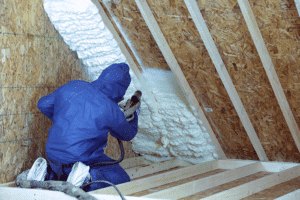Froth/Sponge Foam and Sponge are together assembled, and respected to be in a similar group of elastomeric/plastic materials since they show a similar cell structure. Moreover, they are regularly recorded under comparative industry details (ASTM, MIL, UL, FMVSS, and others). Foam is a lightweight, open-cell item that is ordinarily utilized for protection, filtration, and padding. Spray Insulation Des Moines shows different chemical compositions. As a rule, these cell materials are low thickness to permit air development through the cell structure. Notwithstanding the inheritance applications for customary froth, high-thickness froths have been produced for liquid fixing applications. Conversely, higher thickness froth items will have a higher convergence of cells. Medium and low-thickness froths will have a lower convergence of cells. Wipe is an extended, elastic-based material. The wipe can be prepared in numerous material plans (various mixtures, densities, just as open and shut cell structures). The cells are not associated, which holds the material back from engrossing and holding fluid. Contrasted with froths, wipes are considered to have prevalent mechanical properties. Both Sponge and Foam are accessible in sheets, rolls, and formed or expelled shapes. They can be requested with or without ‘skin’ and PSAs (pressure touchy glue) depending on the situation.

The advancement of shut cell elastomeric froth
First created in the mid-1900s, drastically affects the protection business. The most remarkable explanation behind this is its high dampness obstruction, the consequence of its cell structure—a large number of small boundaries that oppose the movement of fluid. This trademark not just limits the dangers related to dampness (like shape); however, it likewise guarantees consistent, long-haul warm execution. The fluid has a high warmth transaction ability; henceforth, wet protection gives almost no protection by any means. Shut cell elastomeric froth has solid water fume porousness to oppose dampness assimilation, so neither its presentation nor its strength is disabled by the presence of dampness in warming, ventilating, and cooling (HVAC), plumbing, or refrigeration framework. Elastomeric froth protection was created during the 1950s. The presentation of this and other polymer-based materials denoted a significant industry change from the utilization of normal materials, like stoppers, to the utilization of engineered materials and synthetics.
The notoriety of elastomeric protection developed rapidly
That is fundamental because it wiped out the requirement for a fume boundary to forestall the transaction of dampness. As the accessibility of the protection in different structures (counting sheets, rolls, and cylinders) expanded, so did its notoriety as a protector, particularly in refrigeration funneling and ventilation work applications. It was an easy-to-understand option in contrast to different materials since it very well may be reinforced dependably to an assortment of surfaces, it was not difficult to introduce, and its presentation couldn’t be undermined by tears or penetrates. Interest in elastomeric froth has expanded strongly throughout the most recent twenty years because of uplifted attention to indoor air quality (IAQ). Since elastomeric froth doesn’t contain formaldehyde or strands and has exceptionally low unstable natural mixtures (VOCs), it has discovered wide acknowledgment among IAQ advocates. Given its non-articulating. smooth surface and dampness obstruction, elastomeric froth doesn’t uphold the development of shape—ostensibly perhaps the most obliterating IAQ issues that offices face. The Manufacturing Process The three primary segments utilized in the assembling of elastomeric shut cell froth protection incorporates the following: Synthetic elastic mix, regularly nitrile butadiene elastic (NBR), as well as an ethylene-propylene-diene monomer (EPDM) Elastomeric froths, are utilized chlorofluorocarbons (CFCs), hydrochlorofluorocarbons (HCFCs), or hydrofluorocarbons (HFCs), making them reasonable for the hardest natural details.
